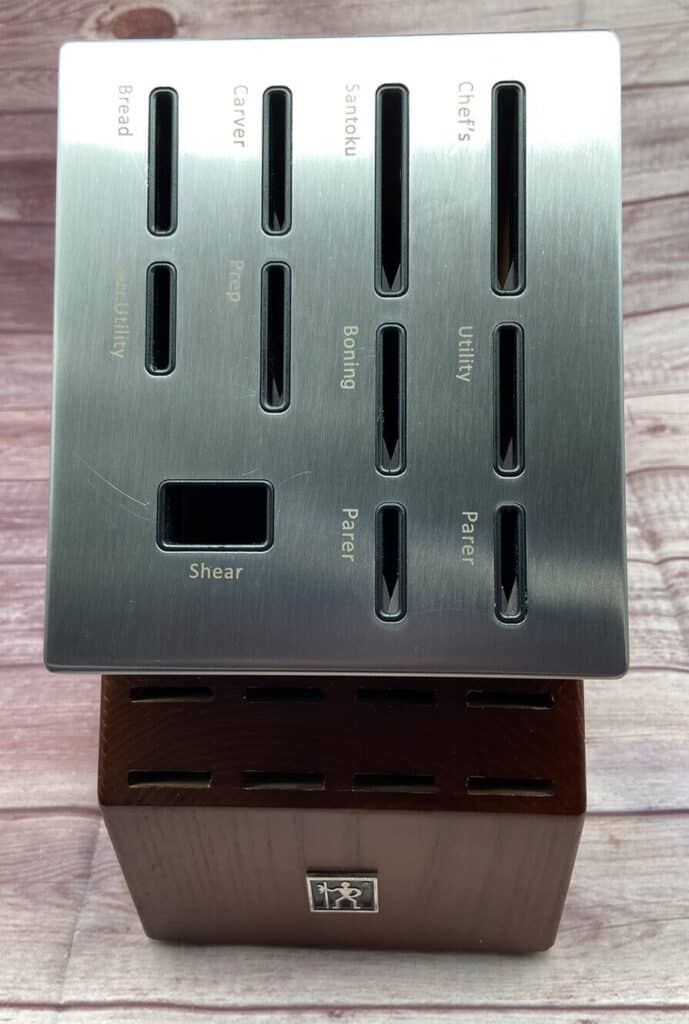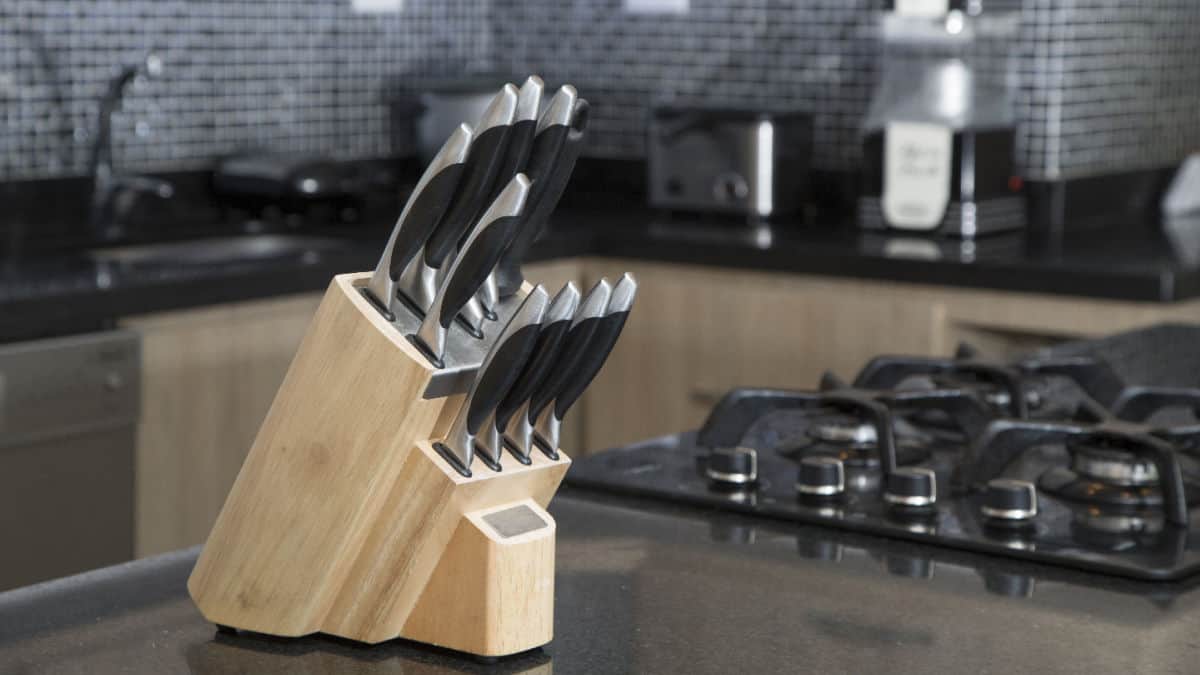As an Amazon Associate I earn from qualifying purchases.
The world of kitchenware has seen various innovations over the years, and one interesting development is the self-sharpening knife block. These specially designed blocks aim to keep your knives sharp and ready to use, eliminating the need for manual sharpening. As convenient as they may sound, many people wonder whether self-sharpening knife blocks actually work or if they’re just a passing trend.
Self-sharpening knife blocks function by incorporating sharpeners at the proper angles within the slots where the knives are stored. Every time a knife is inserted or removed from the block, it receives a touch of sharpening, keeping it sharp and efficient for longer periods. Several users have found these blocks quite helpful, as they save time and effort that would otherwise be spent on manual sharpening.
However, some critics argue that these blocks can damage knives in the long run by wearing them down unevenly. Despite this concern, self-sharpening knife blocks have proven to be effective for many users who prefer convenience in their kitchens. Ultimately, it depends on individual preferences and the specific brand of the block being used.
How Self-Sharpening Knife Blocks Work
The Sharpening Mechanism

Self-sharpening knife blocks have a built-in sharpening mechanism that hones the blade’s edge every time the knife is inserted or withdrawn from the block. This ensures that your knives maintain their sharpness for a longer period, requiring less frequent manual sharpening. The sharpening mechanism usually consists of a set of abrasive surfaces, often made of ceramic or other durable materials.
Slots and Sharpening Surfaces
The knife block contains slots designed to fit specific knives, ensuring proper sharpening angles. Each slot has sharpening surfaces that come into contact with the knife blade’s edge as it slides in and out of the block. These surfaces provide even and consistent sharpening, preventing uneven wear on the blade which can occur with manual sharpening methods.
KIS Technology
Some self-sharpening knife blocks utilize KIS (Keep It Sharp) technology, which automatically adjusts the angle of the sharpening surfaces based on the type of knife being used. This helps to ensure that each knife maintains its optimal sharpness without damaging the blade in the process. The advanced KIS technology can provide a more precise and efficient sharpening experience for your knives.
In summary, self-sharpening knife blocks offer a convenient and efficient solution for maintaining the sharpness of your knives. By incorporating built-in sharpening mechanisms, specific slots, and advanced technologies like KIS, these blocks can save you time and effort in maintaining the quality and performance of your kitchen knives.
Advantages and Disadvantages of Self-Sharpening Knife Blocks
Pros of Self-Sharpening Knife Blocks
- Honing and edge retention: Self-sharpening knife blocks can save you time and effort by eliminating the need to manually sharpen your blades every time you use them. They maintain the cutting performance of your knives, honing the dull edges and ensuring consistent performance in everyday use.
- Safety: Using a self-sharpening knife block also makes cutting tasks safer by maintaining a sharp edge on your knives. Dull knives can be dangerous as they require more force to use and are more likely to slip, potentially causing accidents.
- Quality and Durability: Self-sharpening knife blocks are often made from high-quality materials such as high-quality steel or ceramics which can last longer than traditional knife blocks, justifying their higher price.
Cons of Self-Sharpening Knife Blocks
- Price: One of the main disadvantages of self-sharpening knife blocks is their higher cost compared to regular knife blocks. This may make them less accessible to some users, especially those on a tight budget.
- Limited range of knife compatibility: Self-sharpening knife blocks may not be compatible with all types of knives. Some may only work with specific brands or styles of knives, forcing you to purchase new knives if you want to use the self-sharpening feature.
- Potential for incorrect sharpening angle: While most self-sharpening knife blocks are designed to sharpen knives to an optimal angle, there is a possibility that the angle might not be correct for every type of knife. This could result in uneven sharpening and affect the performance of your knives over time.
In summary, self-sharpening knife blocks offer several advantages, such as honing efficiency, improved safety, and durability, but may have disadvantages like a higher price and compatibility limitations. It is essential to weigh both the pros and cons to determine if a self-sharpening knife block is the right choice for your kitchen.
Comparing Self-Sharpening Knives to Traditional Knife Blocks
Sharpening Maintenance
With self-sharpening knife blocks, you don’t need to sharpen your knives manually since the block takes care of it for you. These blocks have built-in sharpening surfaces within each slot, tailored to the specific knives in your set. This ensures your knives retain their sharpness and remain as efficient as the day you bought them.
In contrast, traditional knife blocks require manual sharpening using a sharpening stone or honing rod. This can be time-consuming and challenging, particularly if you don’t have the necessary skills or patience to maintain the knives properly.
Different Types of Knives and Their Suitability
When it comes to kitchen knives, there are various types available, each designed for specific tasks. Some common types include paring knives, steak knives, and chef’s knives. High-carbon stainless steel is a popular choice for these knives due to its durability, sharpness, and corrosion resistance.
Self-sharpening knife sets accommodate a range of knife types, with each slot tailored to a different knife in the set. This ensures the proper sharpening angle and technique for each knife, contributing to their prolonged sharpness and efficiency. Not all knife sets in the market offer self-sharpening features, so it’s essential to pick the right set according to your needs and preferences.
On the other hand, traditional knife blocks simply provide storage for your knives without any self-sharpening features. You will need to sharpen each type of knife separately, considering their unique angles and blade requirements. This may pose a challenge if you are not familiar with the specific sharpening techniques for each knife type.
Overall, deciding between self-sharpening knives and traditional knife blocks depends on your preferences and willingness to maintain your knives manually. Self-sharpening knife blocks offer convenience and prolong the life of your knives, while traditional knife blocks require more maintenance efforts but can be more budget-friendly.
Choosing the Right Self-Sharpening Knife Block
Factors to Consider
When selecting a self-sharpening knife block, there are several factors to keep in mind. First and foremost, consider the sharpener material, which can be either ceramic or an abrasive material. Ceramic sharpeners tend to be gentler on knives and maintain their sharpness for a longer time. However, they can be more expensive than abrasive materials.
Handles also play a role in the usefulness of a self-sharpening knife block. Opt for knives with full tang handles, which provide more control and balance when using the knives. Full tang handles also ensure the knives are durable and less likely to break.
Comparing reviews can be a helpful way to evaluate the performance of different self-sharpening knife blocks. Make sure to pay attention to the effectiveness of the sharpening mechanism, the storage block design, and the durability of the knives.
Lastly, consider your home cooking needs. If you frequently use specific knives like chef’s knives or santoku knives, make sure the block includes those types of knives and has a sharpening slot specifically designed for them.
Expert Recommendations
Experts have evaluated and recommend some self-sharpening knife blocks to help you find the right one based on the mentioned factors. Here are three popular options:
- ZWILLING Self-Sharpening Knife Block: This block is known for its ceramic sharpeners and robust storage block that keeps your countertop tidy. It is designed to accommodate various knife types and sizes, featuring full tang handles and high-quality steel.
- Calphalon Contemporary SharpIN: A high-end option with an innovative set of knives and a built-in sharpener, this block ensures long-lasting sharpness without the need for a sharpening stone. The knives feature full tang handles and comfortable grip, making them a reliable choice for home cooking enthusiasts.
- Henckels International Statement Self-Sharpening Block Set: Another affordable option that doesn’t compromise on quality. The block includes a range of essential knives for your kitchen needs and features a ceramic sharpener, with slots specifically designed to maintain the sharpness of your knives.
Make sure to research and compare these options against your specific cooking needs, as well as taking into consideration factors such as sharpener material, handles, and reviews, to find the perfect self-sharpening knife block for your kitchen.
Proper Use and Maintenance
Techniques for Effective Sharpening
When using self-sharpening knife blocks, it’s essential to follow the proper techniques to maximize their effectiveness. Gently insert and remove the knife from the block, ensuring that it makes proper contact with the built-in sharpener. Avoid applying excessive pressure, as this could cause damage to the blade or the sharpening mechanism. In addition, consider using a honing rod or a pull-through sharpener occasionally to maintain a sharp cutting edge.
Keeping Blades Sharp
Proper maintenance of your knives is crucial to keeping them sharp and functional. Be sure to:
- Clean knives thoroughly after each use, removing any food particles or residue.
- Store knives in their designated slots within the self-sharpening knife block to protect the cutting edge.
- Use a honing rod or pull-through sharpener as needed to maintain the blade’s sharpness, even when using a self-sharpening block.
- Avoid cutting on hard surfaces, such as glass or granite countertops, which can dull the blade.
Safety Measures
When using self-sharpening knife blocks or any other sharpening devices, adhere to the following safety measures to prevent accidents and ensure proper maintenance:
- Keep knives, sharpeners, and honing rods out of reach of children.
- Use caution when handling sharp blades, ensuring a firm grip on the handle and maintaining a safe distance from the cutting edge.
- Inspect knives regularly for damage or wear, such as chips or dull blades, and address any issues promptly.
- Do not attempt to sharpen shears, scissors or other non-knife tools with a self-sharpening block, as this may cause damage or uproar to the block’s sharpening mechanism.
By following these guidelines and incorporating proper techniques, maintenance, and safety measures, you can effectively use self-sharpening knife blocks and keep your knives in optimal condition.
As an Amazon Associate I earn from qualifying purchases.

